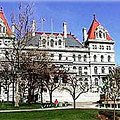- By Nicole Hanks
- News
 Print
Print  Local governments and school districts across New York have lost a significant amount of revenue as a result of the Great Recession, according to the 2010 Annual Report on Local Governments released today by New York State Comptroller Thomas P. DiNapoli. While there are some indications that New York’s economy is beginning to stabilize, the road to fiscal health will not be an easy one, DiNapoli said.
Local governments and school districts across New York have lost a significant amount of revenue as a result of the Great Recession, according to the 2010 Annual Report on Local Governments released today by New York State Comptroller Thomas P. DiNapoli. While there are some indications that New York’s economy is beginning to stabilize, the road to fiscal health will not be an easy one, DiNapoli said.“In many respects, the true pain of the recession is continuing to be felt by local governments in New York,” DiNapoli said. “Local governments have lost hundreds of millions of dollars in local and state revenue. The road to recovery will likely be a long and tough one. In some cases, it could take years of sustained growth for revenue to return to the levels prior to the recession."
“Painful as it is, the fiscal crisis has created some real opportunities for reform. If we seize those opportunities, we can make New York work better. My office has created tools to help local governments weather this financial storm, fix what’s broken, and save taxpayers money. We shouldn’t waste this crisis.”
DiNapoli said that while the excessive loss of tax and other local revenues has slowed, regaining what has been lost is not likely in the next year:
- Sales Tax: County sales tax collections declined by $394 million or 5.9 percent in 2009 compared to 2008. A growth rate of 6.3 percent in 2010, which is highly unlikely, would be needed just to get back to 2008 levels;
- Property Tax: Many localities – including 23 percent of school districts, nearly 30 percent of cities and 16 percent of counties – experienced a reduction in property value from 2008 to 2009, averaging losses of 3.5 percent in property wealth. When property values decrease, local governments face a potential loss in property tax levy unless rates are increased;
- Mortgage Recording Tax: Towns lost more than $189 million, or about 40 percent, of revenue generated through the mortgage recording tax between 2004 and 2008, and indications are that this loss could grow to more than $230 million when 2009 numbers are final. Mortgage recording tax revenues would need to grow by over 15 percent a year for five consecutive years to return to 2006 levels;
- Interest Earnings: Total revenues generated through interest and other earnings declined by $281 million, or 26.9 percent, between 2007 and 2008. In 2009, the decline in these revenues accelerated, resulting in losses of over half a billion dollars in earnings from peak-to-trough; and
- State Aid: Since 2008-09, aid for all cities (other than New York City), towns and villages decreased by nearly $30 million. New York City lost more than $300 million during that same time period. Given the state’s out-year budget gaps, it is unlikely this revenue will return to pre-recession levels in the near future.
Local governments and school districts will have to continue dealing with the “trickledown effect” of revenue shortfalls experienced at the state level. Optimistic budget assumptions could create budget gaps in the 2010-11 state fiscal year.
DiNapoli’s report calls for changes to the way New York conducts its governmental operations by reforming the budget process, repairing the recurring budget problems and reducing out-year budget gaps without resorting to debt.
DiNapoli’s office has created several new planning tools to help local government officials manage their finances and streamline their operations to achieve greater efficiency and transparency:
- Multiyear financial planning packages – to help local officials assess their current financial condition and learn how to improve it in the future;
- Shared services packages – to provide a step-by-step guide for local officials on how to begin the process of creating a shared service program; and
- OSC cost savings audits – that review local governments’ and school districts’ operations to help officials determine where they could cut waste, save money and enhance revenues.
DiNapoli’s report notes that local governments across the state could save as much as $765 million by sharing certain administrative and business office functions. The potential for savings in program areas – such as transportation, property assessment and health insurance – could be much greater. To date, DiNapoli’s efforts have identified more than $1.3 billion in potential local government savings. In addition, DiNapoli’s report recommends local governments and school districts begin planning immediately for the phase out of additional federal assistance.
----
v6i26



